Design and Characterization of Yeast Protein–Polysaccharide Bioink Blends for 3D Printing
Abstract
1. Introduction
2. Materials and Methods
2.1. Materials
2.2. Preparation and Characterization of YP Solutions
2.2.1. Zeta Potential Analysis
2.2.2. SDS-PAGE
2.3. Preparation of the YP–Alg, YP–XG and YP–Alg–XG Bioink Blends
2.4. Preparation of the YP–Alg, YP–XG–YP and YP–Alg–XG Cross-Linked Hydrogels
2.5. Fourier Transform Infrared (FTIR)
2.6. Rheological Properties
2.7. Mechanical Properties
2.8. Water Uptake and Stability Experiments
2.9. Embedded 3D Bioprinting
2.10. Statistical Analysis
3. Results and Discussion
3.1. YP Characterization
3.2. YP–Alg Bioink Characterization
3.3. YP–XG Bioink Characterization
3.4. YP–Alg–XG Triple Bioink Characterization
3.5. Mechanical Characterization of Crosslinked Triple Hydrogels
3.6. Three-Dimensional Printing of YP–Alg–XG Bioink Blends
3.7. Stability Characterization of Crosslinked Hydrogels
4. Conclusions
Supplementary Materials
Author Contributions
Funding
Data Availability Statement
Acknowledgments
Conflicts of Interest
References
- Ma, J.; Sun, Y.; Meng, D.; Zhou, Z.; Zhang, Y.; Yang, R. Yeast proteins: The novel and sustainable alternative protein in food applications. Trends Food Sci. Technol. 2023, 135, 190–201. [Google Scholar] [CrossRef]
- Jach, M.E.; Serefko, A.; Ziaja, M.; Kieliszek, M. Yeast Protein as an Easily Accessible Food Source. Metabolites 2022, 12, 63. [Google Scholar] [CrossRef]
- Agboola, J.O.; Øverland, M.; Skrede, A.; Hansen, J.Ø. Yeast as major protein-rich ingredient in aquafeeds: A review of the implications for aquaculture production. Rev. Aquac. 2021, 13, 949–970. [Google Scholar] [CrossRef]
- Cao, X.; Liu, H.; Yang, M.; Mao, K.; Wang, X.; Chen, Z.; Ran, M.; Hao, L. Evaluation of the nutritional quality of yeast protein in comparison to animal and plant proteins using growing rats and INFOGEST model. Food Chem. 2025, 463, 141178. [Google Scholar] [CrossRef]
- Wang, S.; Huang, F.; Zhao, Y.; Ouyang, K.; Xie, H.; Xiong, H.; Zhang, Y.; Chen, Z.; Zhao, Q. Slow-digestive yeast protein concentrate: An investigation of its in vitro digestibility and digestion behavior. Food Res. Int. 2023, 174, 113572. [Google Scholar] [CrossRef]
- Timira, V.; Chen, X.; Zhou, P.; Wu, J.; Wang, T. Potential use of yeast protein in terms of biorefinery, functionality, and sustainability in food industry. Compr. Rev. Food Sci. Food Saf. 2024, 23, e13326. [Google Scholar] [CrossRef]
- Ma, Y.; Chen, F. Plant Protein Heat-Induced Gels: Formation Mechanisms and Regulatory Strategies. Coatings 2023, 13, 1899. [Google Scholar] [CrossRef]
- Zhang, Q.; Liu, Y.; Yang, G.; Kong, H.; Guo, L.; Wei, G. Recent advances in protein hydrogels: From design, structural and functional regulations to healthcare applications. Chem. Eng. J. 2023, 451, 138494. [Google Scholar] [CrossRef]
- Ma, C.; Xia, S.; Song, J.; Hou, Y.; Hao, T.; Shen, S.; Li, K.; Xue, C.; Jiang, X. Yeast protein as a novel protein source: Processing, functional properties, and potential applications in foods. Innov. Food Sci. Emerg. Technol. 2024, 93, 103606. [Google Scholar] [CrossRef]
- Bodenberger, N.; Kubiczek, D.; Paul, P.; Preising, N.; Weber, L.; Bosch, R.; Hausmann, R.; Gottschalk, K.-E.; Rosenau, F. Beyond bread and beer: Whole cell protein extracts from baker’s yeast as a bulk source for 3D cell culture matrices. Appl. Microbiol. Biotechnol. 2017, 101, 1907–1917. [Google Scholar] [CrossRef] [PubMed]
- Wang, Y.; Zhong, Z.; Munawar, N.; Zan, L.; Zhu, J. 3D edible scaffolds with yeast protein: A novel alternative protein scaffold for the production of high-quality cell-cultured meat. Int. J. Biol. Macromol. 2024, 259, 129134. [Google Scholar] [CrossRef]
- Kong, Y.; Chen, J.; Guo, R.; Huang, Q. Regulation of tapioca starch 3D printability by yeast protein: Rheological, textural evaluation, and machine learning prediction. J. Food Eng. 2025, 387, 112341. [Google Scholar] [CrossRef]
- Xia, S.; Shen, S.; Song, J.; Li, K.; Qin, X.; Jiang, X.; Xue, C.; Xue, Y. Physicochemical and structural properties of meat analogues from yeast and soy protein prepared via high-moisture extrusion. Food Chem. 2023, 402, 134265. [Google Scholar] [CrossRef] [PubMed]
- Xia, S.; Song, J.; Li, K.; Hao, T.; Ma, C.; Shen, S.; Jiang, X.; Xue, C.; Xue, Y. Yeast protein-based meat analogues: Konjac glucomannan induces the fibrous structure formation by modifying protein structure. Food Hydrocoll. 2023, 142, 108798. [Google Scholar] [CrossRef]
- Radhakrishnan, J.; Subramanian, A.; Krishnan, U.M.; Sethuraman, S. Injectable and 3D Bioprinted Polysaccharide Hydrogels: From Cartilage to Osteochondral Tissue Engineering. Biomacromolecules 2017, 18, 1–26. [Google Scholar] [CrossRef] [PubMed]
- Gheorghita Puscaselu, R.; Lobiuc, A.; Dimian, M.; Covasa, M. Alginate: From Food Industry to Biomedical Applications and Management of Metabolic Disorders. Polymers 2020, 12, 2417. [Google Scholar] [CrossRef]
- Abka-Khajouei, R.; Tounsi, L.; Shahabi, N.; Patel, A.K.; Abdelkafi, S.; Michaud, P. Structures, Properties and Applications of Alginates. Mar. Drugs 2022, 20, 364. [Google Scholar] [CrossRef]
- Mallakpour, S.; Azadi, E.; Hussain, C.M. State-of-the-art of 3D printing technology of alginate-based hydrogels—An emerging technique for industrial applications. Adv. Colloid Interface Sci. 2021, 293, 102436. [Google Scholar] [CrossRef]
- Ianovici, I.; Zagury, Y.; Redenski, I.; Lavon, N.; Levenberg, S. 3D-printable plant protein-enriched scaffolds for cultivated meat development. Biomaterials 2022, 284, 121487. [Google Scholar] [CrossRef]
- Ianovici, I.; Zagury, Y.; Afik, N.; Hendel, M.; Lavon, N.; Levenberg, S. Embedded three-dimensional printing of thick pea-protein-enriched constructs for large, customized structured cell-based meat production. Biofabrication 2024, 16, 045023. [Google Scholar] [CrossRef]
- Patel, J.; Maji, B.; Moorthy, N.S.H.N.; Maiti, S. Xanthan gum derivatives: Review of synthesis, properties and diverse applications. RSC Adv. 2020, 10, 27103–27136. [Google Scholar] [CrossRef]
- Nsengiyumva, E.M.; Alexandridis, P. Xanthan gum in aqueous solutions: Fundamentals and applications. Int. J. Biol. Macromol. 2022, 216, 583–604. [Google Scholar] [CrossRef]
- Vaishnav, A.; Choudhary, D.K. (Eds.) Microbial Polymers: Applications and Ecological Perspectives; Springer: Singapore, 2021. [Google Scholar] [CrossRef]
- Teixeira, M.C.; Lameirinhas, N.S.; Carvalho, J.P.F.; Silvestre, A.J.D.; Vilela, C.; Freire, C.S.R. A Guide to Polysaccharide-Based Hydrogel Bioinks for 3D Bioprinting Applications. Int. J. Mol. Sci. 2022, 23, 6564. [Google Scholar] [CrossRef]
- Liu, Y.; Zhang, Y.; Cai, L.; Zeng, Q.; Wang, P. Protein and protein-polysaccharide composites-based 3D printing: The properties, roles and opportunities in future functional foods. Int. J. Biol. Macromol. 2024, 272, 132884. [Google Scholar] [CrossRef] [PubMed]
- Guo, Z.; Arslan, M.; Li, Z.; Cen, S.; Shi, J.; Huang, X.; Xiao, J.; Zou, X. Application of Protein in Extrusion-Based 3D Food Printing: Current Status and Prospectus. Foods 2022, 11, 1902. [Google Scholar] [CrossRef]
- Wollschlaeger, J.O.; Maatz, R.; Albrecht, F.B.; Klatt, A.; Heine, S.; Blaeser, A.; Kluger, P.J. Scaffolds for Cultured Meat on the Basis of Polysaccharide Hydrogels Enriched with Plant-Based Proteins. Gels 2022, 8, 94. [Google Scholar] [CrossRef]
- Khoeini, R.; Nosrati, H.; Akbarzadeh, A.; Eftekhari, A.; Kavetskyy, T.; Khalilov, R.; Ahmadian, E.; Nasibova, A.; Datta, P.; Roshangar, L.; et al. Natural and Synthetic Bioinks for 3D Bioprinting. Adv. NanoBiomed. Res. 2021, 1, 2000097. [Google Scholar] [CrossRef]
- Sun, J.; Yang, X.; Diao, J.; Wang, Y.; Wang, C. Exploration of Pea Protein Isolate–Sodium Alginate Complexes as a Novel Strategy to Substitute Sugar in Plant Cream: Synergistic Interactions Between the Two at the Interface. Foods 2025, 14, 991. [Google Scholar] [CrossRef]
- Makshakova, O.N.; Zuev, Y.F. Interaction-Induced Structural Transformations in Polysaccharide and Protein-Polysaccharide Gels as Functional Basis for Novel Soft-Matter: A Case of Carrageenans. Gels 2022, 8, 287. [Google Scholar] [CrossRef] [PubMed]
- Ansari, S.; Rashid, A.I.; Waghmare, P.R.; Nobes, D.S. Measurement of the flow behavior index of Newtonian and shear-thinning fluids via analysis of the flow velocity characteristics in a mini-channel. SN Appl. Sci. 2020, 2, 1787. [Google Scholar] [CrossRef]
- Wang, Y.; Qin, H.; Li, Z.; Dai, J.; Cong, H.-P.; Yu, S.-H. Highly compressible and environmentally adaptive conductors with high-tortuosity interconnected cellular architecture. Nat. Synth. 2022, 1, 975–986. [Google Scholar] [CrossRef]
- Li, J.; Liu, H.; Wang, C.; Huang, G. A facile method to fabricate hybrid hydrogels with mechanical toughness using a novel multifunctional cross-linker. RSC Adv. 2017, 7, 35311–35319. [Google Scholar] [CrossRef]
- Hen, N.; Josef, E.; Davidovich-Pinhas, M.; Levenberg, S.; Bianco-Peled, H. On the Relation between the Viscoelastic Properties of Granular Hydrogels and Their Performance as Support Materials in Embedded Bioprinting. ACS Biomater. Sci. Eng. 2024, 10, 6734–6750. [Google Scholar] [CrossRef]
- Machour, M.; Hen, N.; Goldfracht, I.; Safina, D.; Davidovich-Pinhas, M.; Bianco-Peled, H.; Levenberg, S. Print-and-Grow within a Novel Support Material for 3D Bioprinting and Post-Printing Tissue Growth. Adv. Sci. 2022, 9, e2200882. [Google Scholar] [CrossRef] [PubMed]
- Lee, S.; Kim, E.; Jo, M.; Choi, Y.J. Characterization of yeast protein isolates extracted via high-pressure homogenization and pH shift: A promising protein source enriched with essential amino acids and branched-chain amino acids. J. Food Sci. 2024, 89, 900–912. [Google Scholar] [CrossRef]
- Li, J.; Karboune, S. A comparative study for the isolation and characterization of mannoproteins from Saccharomyces cerevisiae yeast cell wall. Int. J. Biol. Macromol. 2018, 119, 654–661. [Google Scholar] [CrossRef]
- Verkempinck, S.H.E.; Duijsens, D.; Mukherjee, A.; Wilde, P.J. Pea protein extraction method impacts the protein (micro)structural organisation and in vitro digestion kinetics. Food Funct. 2024, 15, 953–966. [Google Scholar] [CrossRef] [PubMed]
- Sibt-E.-Abbas, M.; Butt, M.S.; Riaz, M.N.; Teferra, T.F.; Ul-Haq, I. Amino Acid Profiling and SDS-PAGE Analysis of Protein Isolates Obtained from Nonconventional Sources. J. Food Qual. 2022, 2022, 1926527. [Google Scholar] [CrossRef]
- De Kruif, C.; Tuinier, R. Polysaccharide protein interactions. Food Hydrocoll. 2001, 15, 555–563. [Google Scholar] [CrossRef]
- Belalia, F.; Djelali, N.-E. Rheological properties of sodium alginate solutions. Rev. Roum. Chim. 2014, 59, 135–145. [Google Scholar]
- Brzezińska, M.; Szparaga, G. The Effect of Sodium Alginate Concentration on The Rheological Parameters Of Spinning Solutions. Autex Res. J. 2015, 15, 123–126. [Google Scholar] [CrossRef]
- Hendel, G.; Hen, N.; Levenberg, S.; Bianco-Peled, H. Pea Protein—ĸ-Carrageenan Nanoparticles for Edible Pickering Emulsions. Polysaccharides 2025, 6, 14. [Google Scholar] [CrossRef]
- Zhang, L.-M.; Kong, T. Aqueous polysaccharide blends based on hydroxypropyl guar gum and carboxymethyl cellulose: Synergistic viscosity and thixotropic properties. Colloid Polym. Sci. 2006, 285, 145–151. [Google Scholar] [CrossRef]
- Kamdem, I.E.N.; Saidou, C.; Ngassoum, M.B.; Ndjouenkeu, R. Synergistic interactions in dilute aqueous solutions between alginate and tropical vegetal hydrocolloids. Heliyon 2020, 6, e04348. [Google Scholar] [CrossRef]
- Chen, Z.; Sun, S.; Zhou, Q.; Wang, X.; Hu, J.; Zhou, P. HIPE-gels performance: Role of sodium hyaluronate conformation and concentration in structure and 3D printing. Food Biosci. 2025, 67, 106361. [Google Scholar] [CrossRef]
- Pereira, L.; Amado, A.M.; Critchley, A.T.; van de Velde, F.; Ribeiro-Claro, P.J. Identification of selected seaweed polysaccharides (phycocolloids) by vibrational spectroscopy (FTIR-ATR and FT-Raman). Food Hydrocoll. 2009, 23, 1903–1909. [Google Scholar] [CrossRef]
- Peleg-Evron, O.; Davidovich-Pinhas, M.; Bianco-Peled, H. Crosslinking konjac-glucomannan with kappa-carrageenan nanogels: A step toward the design of sacrificial materials. Int. J. Biol. Macromol. 2023, 227, 654–663. [Google Scholar] [CrossRef]
- Cofelice, M.; Messia, M.C.; Marconi, E.; Cuomo, F.; Lopez, F. Effect of the xanthan gum on the rheological properties of alginate hydrogels. Food Hydrocoll. 2023, 142, 108768. [Google Scholar] [CrossRef]
- Xu, J.; Fan, Y.; Liu, H.; Liu, Q.; Zhamsaranova, S.; Kong, B.; Chen, Q. Improvement of rheological properties and 3D printability of pork pastes by the addition of xanthan gum. LWT 2023, 173, 114325. [Google Scholar] [CrossRef]
- Kaczmarczyk, K.; Kruk, J.; Ptaszek, P.; Ptaszek, A. Pressure Drop Method as a Useful Tool for Detecting Rheological Properties of Non-Newtonian Fluids during Flow. Appl. Sci. 2021, 11, 6583. [Google Scholar] [CrossRef]
- Caballero, M.S.; de Monterrey, T.; Valdez-Fragoso, A.; Salinas-López, A.; Chanes, J.W.; Verardo, V.; Mújica-Paz, H. Rheological parameters of xanthan gum/pectin solutions as afunction of temperature and composition. Rev. Mex. Ing. Quimica 2016, 15, 859–868. [Google Scholar] [CrossRef]
- Baniasadi, H.; Kimiaei, E.; Polez, R.T.; Ajdary, R.; Rojas, O.J.; Österberg, M.; Seppälä, J. High-resolution 3D printing of xanthan gum/nanocellulose bio-inks. Int. J. Biol. Macromol. 2022, 209, 2020–2031. [Google Scholar] [CrossRef] [PubMed]
- Li, J.; Moeinzadeh, S.; Kim, C.; Pan, C.-C.; Weale, G.; Kim, S.; Abrams, G.; James, A.W.; Choo, H.; Chan, C.; et al. Development and systematic characterization of GelMA/alginate/PEGDMA/xanthan gum hydrogel bioink system for extrusion bioprinting. Biomaterials 2023, 293, 121969. [Google Scholar] [CrossRef]
- Wan, L.Q.; Jiang, J.; Arnold, D.E.; Guo, X.E.; Lu, H.H.; Mow, V.C. Calcium Concentration Effects on the Mechanical and Biochemical Properties of Chondrocyte-Alginate Constructs. Cell. Mol. Bioeng. 2008, 1, 93–102. [Google Scholar] [CrossRef]
- Girón-Hernández, J.; Gentile, P.; Benlloch-Tinoco, M. Impact of heterogeneously crosslinked calcium alginate networks on the encapsulation of β-carotene-loaded beads. Carbohydr. Polym. 2021, 271, 118429. [Google Scholar] [CrossRef]
- Buyanov, A.; Gofman, I.; Saprykina, N. High-strength cellulose–polyacrylamide hydrogels: Mechanical behavior and structure depending on the type of cellulose. J. Mech. Behav. Biomed. Mater. 2019, 100, 103385. [Google Scholar] [CrossRef]
- Sartore, L.; Manferdini, C.; Saleh, Y.; Dey, K.; Gabusi, E.; Ramorino, G.; Zini, N.; Almici, C.; Re, F.; Russo, D.; et al. Polysaccharides on gelatin-based hydrogels differently affect chondrogenic differentiation of human mesenchymal stromal cells. Mater. Sci. Eng. C 2021, 126, 112175. [Google Scholar] [CrossRef] [PubMed]
- Drozdov, A.; Christiansen, J.D. Tension–compression asymmetry in the mechanical response of hydrogels. J. Mech. Behav. Biomed. Mater. 2020, 110, 103851. [Google Scholar] [CrossRef]
- McCormack, A.; Highley, C.B.; Leslie, N.R.; Melchels, F.P. 3D Printing in Suspension Baths: Keeping the Promises of Bioprinting Afloat. Trends Biotechnol. 2020, 38, 584–593. [Google Scholar] [CrossRef]
- Barkay-Olami, H.; Zilberman, M. Novel porous soy protein-based blend structures for biomedical applications: Microstructure, mechanical, and physical properties. J. Biomed. Mater. Res. Part B Appl. Biomater. 2016, 104, 1109–1120. [Google Scholar] [CrossRef]
- Wu, L.; Schroën, K.; Corstens, M. Structural stability and release properties of emulsion-alginate beads under gastrointestinal conditions. Food Hydrocoll. 2024, 150, 109702. [Google Scholar] [CrossRef]
- Gómez-Mascaraque, L.G.; Martínez-Sanz, M.; Hogan, S.A.; López-Rubio, A.; Brodkorb, A. Nano- and microstructural evolution of alginate beads in simulated gastrointestinal fluids. Impact of M/G ratio, molecular weight and pH. Carbohydr. Polym. 2019, 223, 115121. [Google Scholar] [CrossRef]
- Zhang, Z.; Zhang, R.; McClements, D.J. Control of protein digestion under simulated gastrointestinal conditions using biopolymer microgels. Food Res. Int. 2017, 100, 86–94. [Google Scholar] [CrossRef] [PubMed]
- Gheorghita, R.; Sirbu, I.-O.; Lobiuc, A.; Covasa, M. Sodium Alginate–Starch Capsules for Enhanced Stability of Metformin in Simulated Gastrointestinal Fluids. Biomimetics 2024, 9, 716. [Google Scholar] [CrossRef] [PubMed]
- Ni, F.; Luo, X.; Zhao, Z.; Yuan, J.; Song, Y.; Liu, C.; Huang, M.; Dong, L.; Xie, H.; Cai, L.; et al. Enhancing viability of Lactobacillus plantarum encapsulated by alginate-gelatin hydrogel beads during gastrointestinal digestion, storage and in the mimic beverage systems. Int. J. Biol. Macromol. 2023, 224, 94–104. [Google Scholar] [CrossRef] [PubMed]
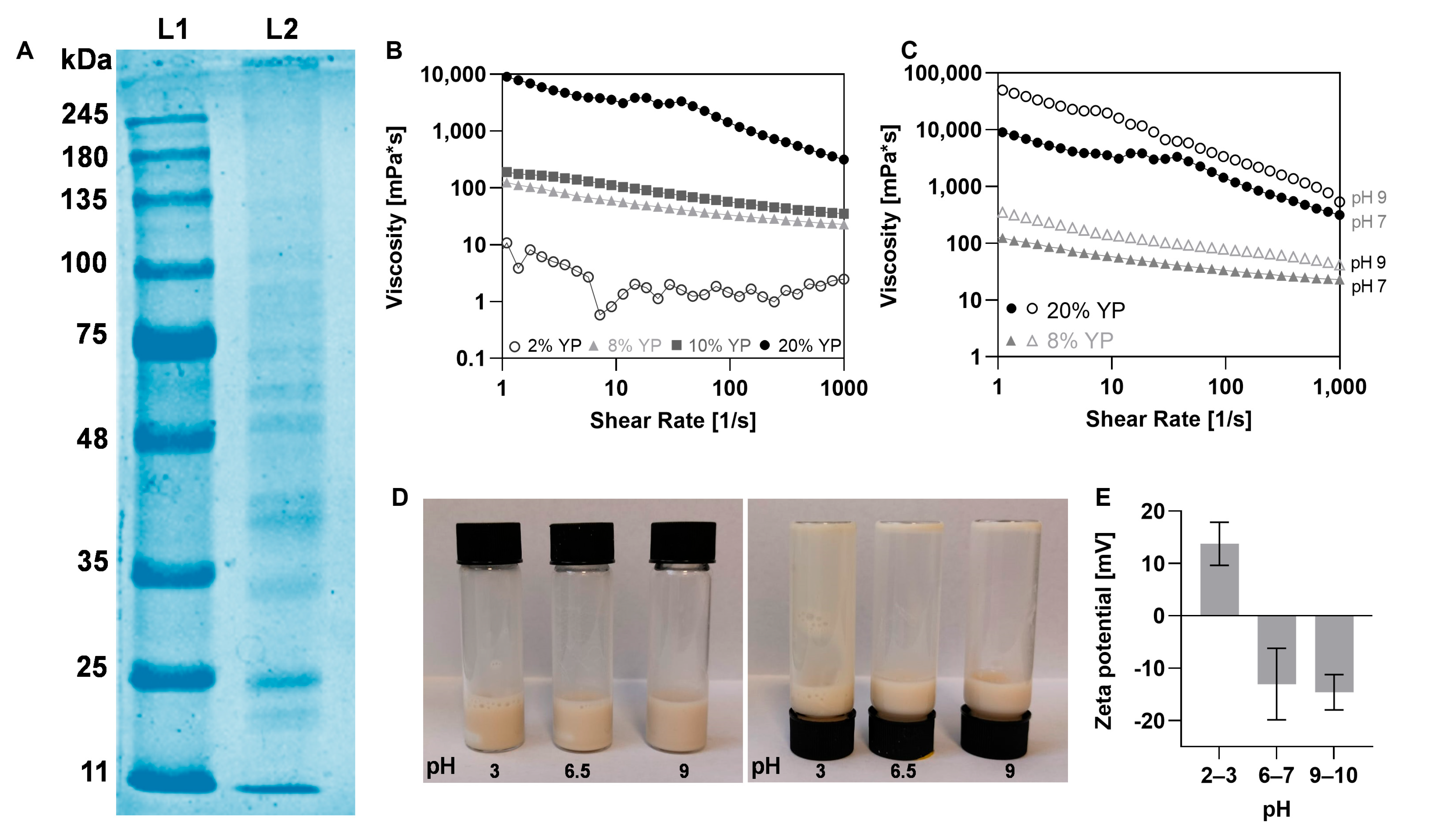
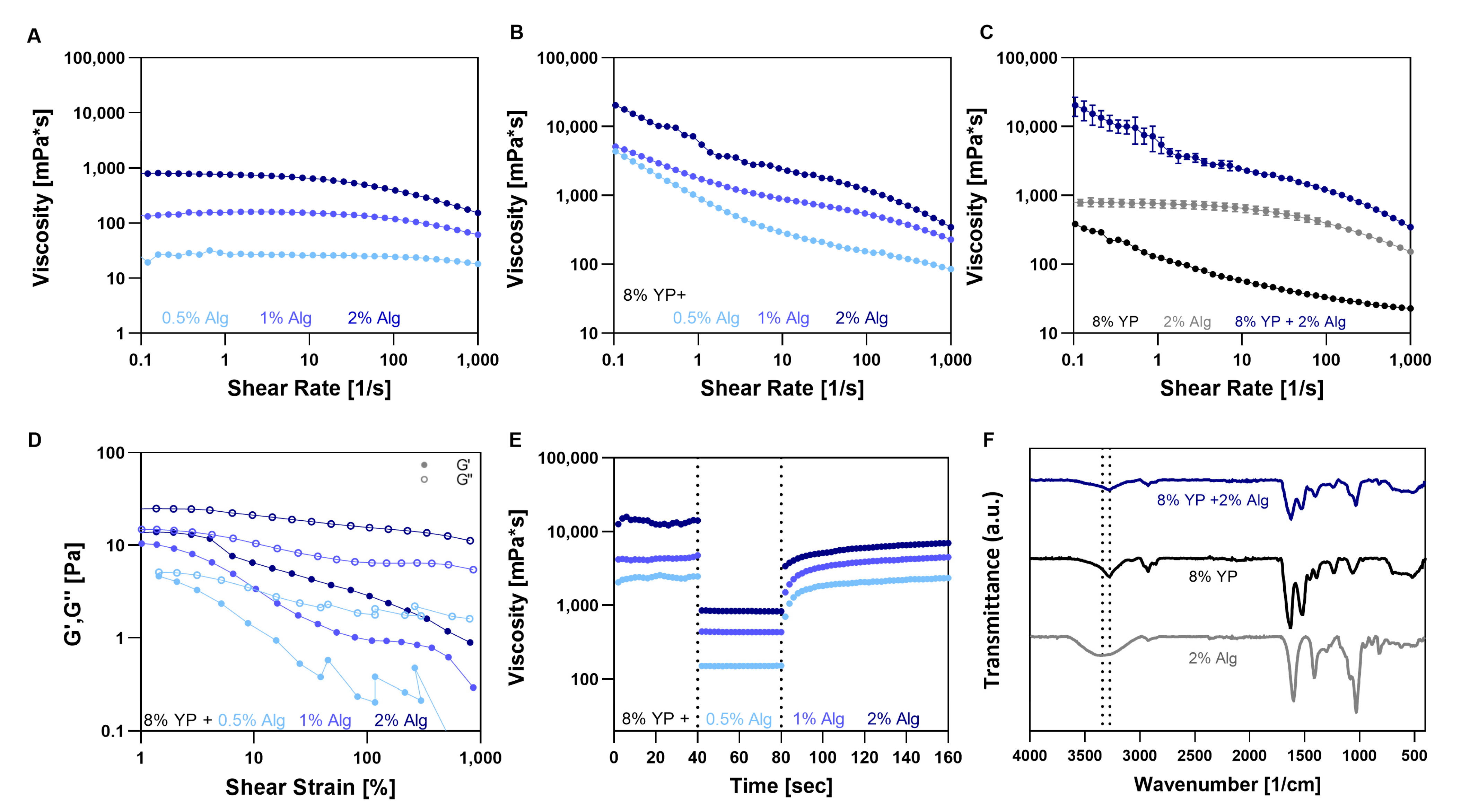

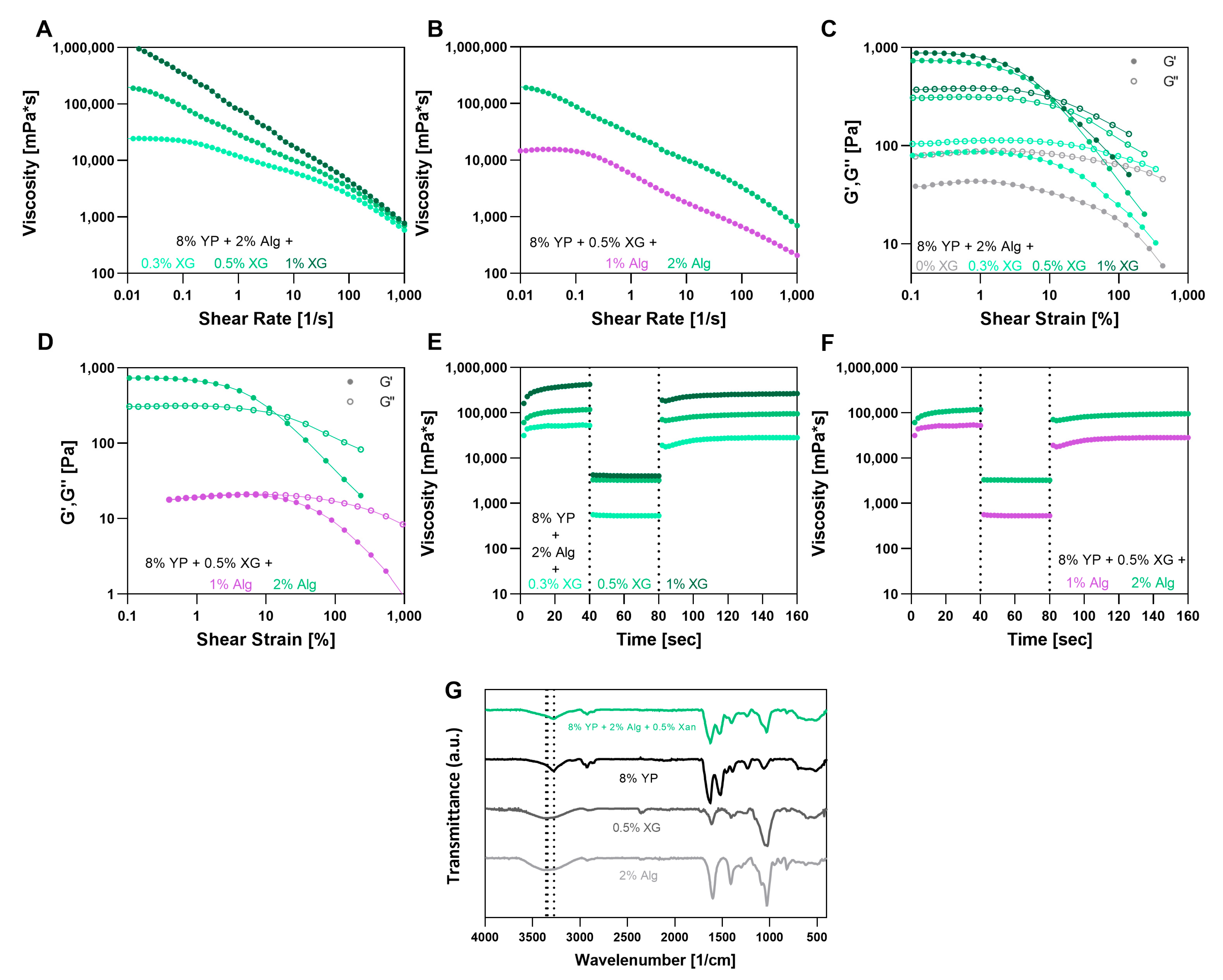
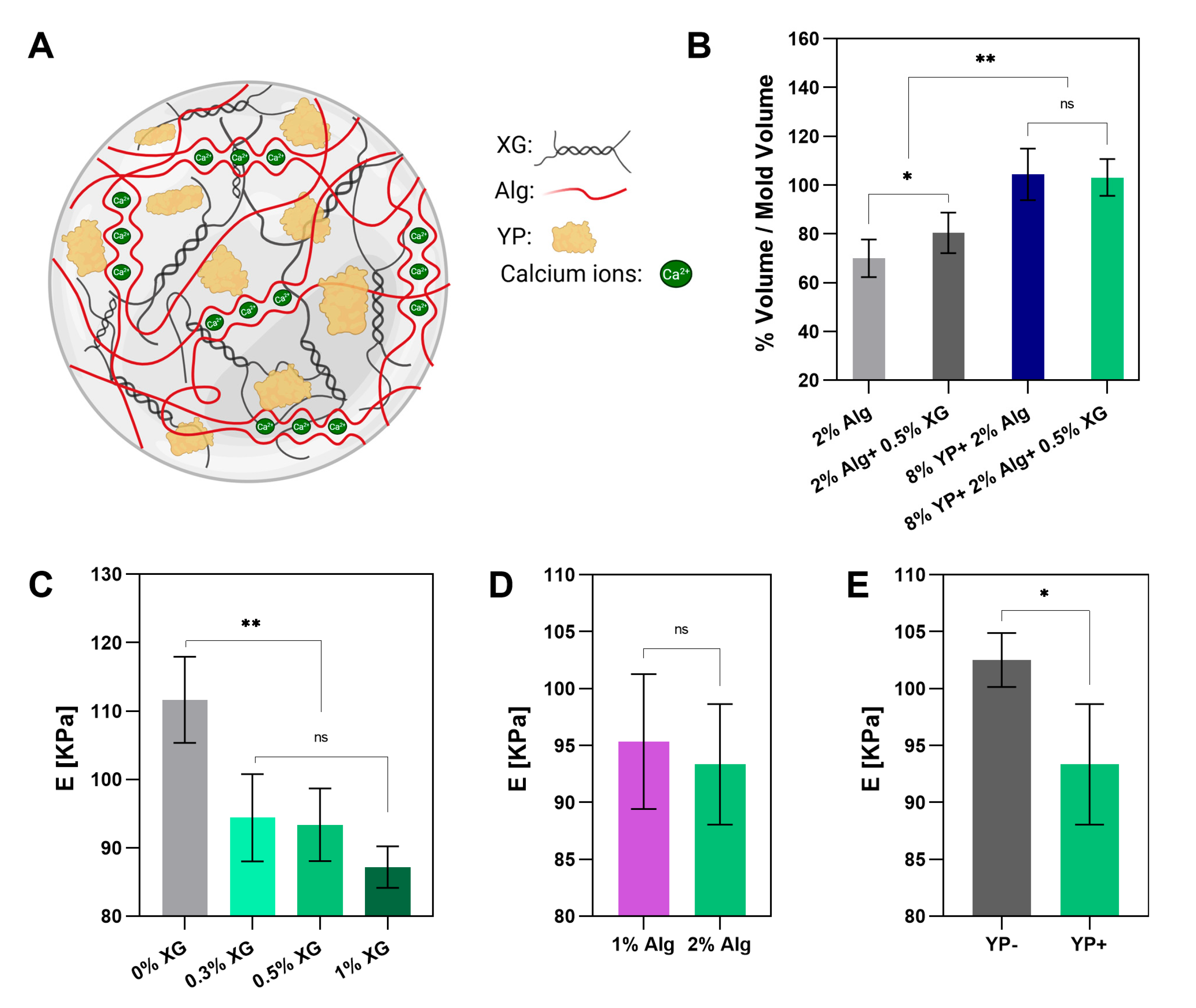

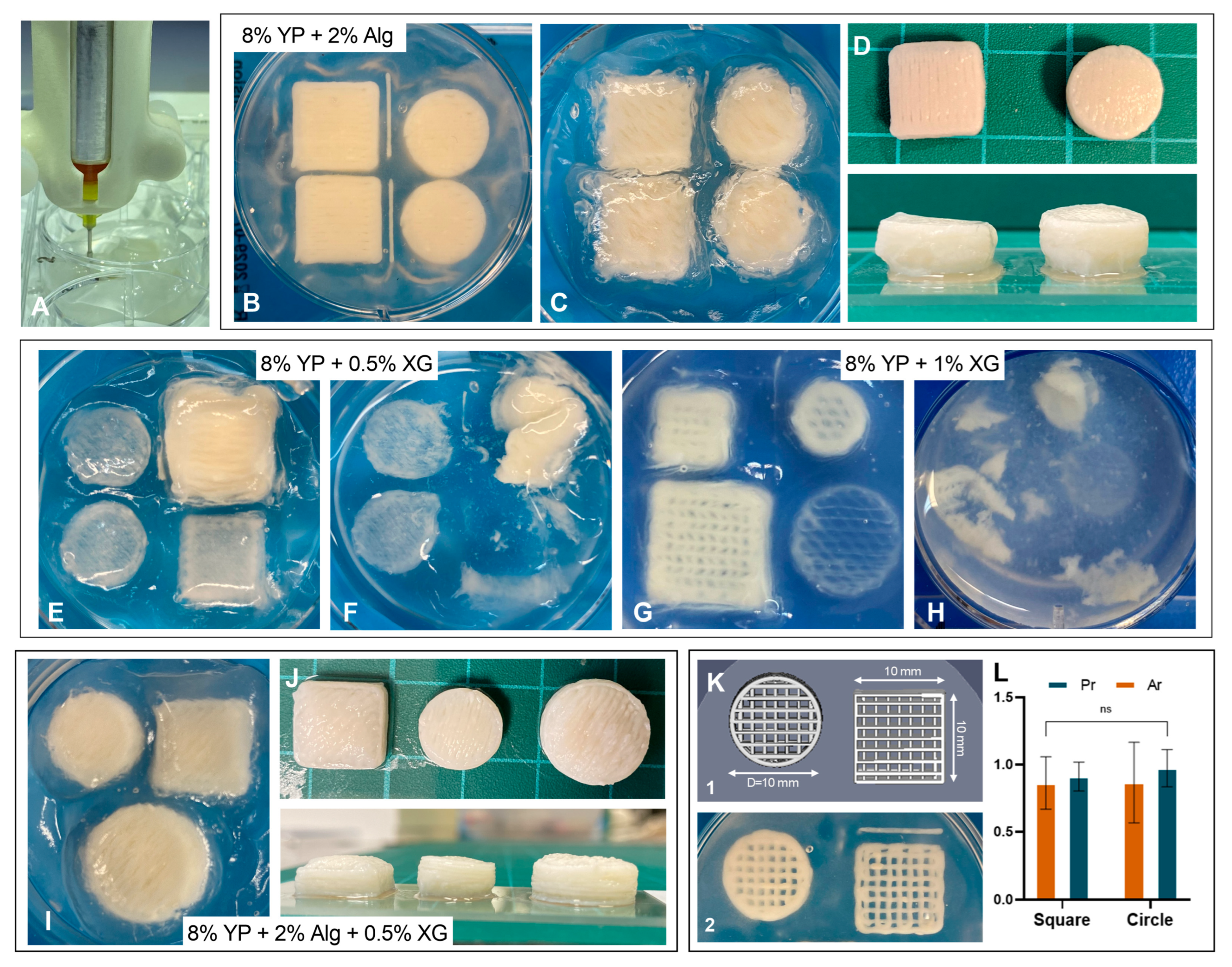

| Bioink | % (w/v) YP | % (w/v) Alg | % (w/v) XG |
|---|---|---|---|
| Binary blends | 8 | 2 | - |
| 8 | - | 0.5 | |
| 8 | - | 1 | |
| Triple blend | 8 | 2 | 0.5 |
| % (w/v) | % (w/v) YP | Flow Index n | Zero Viscosity η0 [mPa·sec] | G′ Average at LVR [Pa] | Crossover Strain (G′ = G″) [%] | % Recovery | |
|---|---|---|---|---|---|---|---|
| 0 | 8 | 0.61 ± 0.08 e | - | - | - | - | |
| Alg | 0.5 | 0 | 0.89 ± 0.00 * | 28 ± 5 a | - | - | - |
| 5 | 0.67 ± 0.01 e | 1292 ± 56 d | 2.8 ± 0.8 b | - | - | ||
| 8 | 0.59 ± 0.00 e | 10,332 ± 56 h | 3.2 ± 0.1 b | ND | 89 ± 4 b | ||
| 1 | 0 | 0.74 ± 0.03 * | 161 ± 36 b | - | - | - | |
| 5 | 0.80 ± 0.02 f | 1520 ± 62 e | - | - | - | ||
| 8 | 0.70 ± 0.04 e | 10,526 ± 561 h | 7 ± 0.5 c | ND | 87 ± 9 b | ||
| 2 | 0 | 0.59 ± 0.02 * | 773 ± 83 c | 0.45 ± 0.1 a | ND | - | |
| 5 | 0.79 ± 0.02 f | 2709 ± 409 f | - | - | - | ||
| 8 | 0.66 ± 0.02 e | 14,056 ± 498 i | 10 ± 1 d | ND | 63 ± 9 a | ||
| XG | 0.5 | 0 | 0.34 ± 0.05 d | 7449 ± 660 g | 9.8 ± 0.3 d | 200 ± 20 c | - |
| 5 | 0.4 ± 0.00 d | 18,676 ± 1530 j | 18.5 ± 0.6 e | - | - | ||
| 8 | 0.36 ± 0.01 d | 48,296 ± 2735 k | 36 ± 1 f | 57 ± 12 a | 100 ± 1 c | ||
| 1 | 0 | 0.17 ± 0.01 b | 83,649 ± 3885 | - | - | - | |
| 5 | 0.23 ± 0.05 c | 115,700 ± 17,274 l | - | - | - | ||
| 8 | 0.25 ± 0.01 c | 170,413 ± 1726 m | 85 ± 16 g | 77 ± 17 ab | 94 ± 4 b | ||
| 1.5 | 0 | 0.13 ± 0.00 a | 133,185 ± 7799 l | - | - | - | |
| 5 | 0.23 ± 0.00 c | 202,926 ± 13,057 n | - | - | - | ||
| 8 | 0.21 ± 0.01 c | 448,147 ± 86,798 o | 184 ± 7 h | 105 ± 13 b | 89 ± 5 b |
| % (w/v) Alg | % (w/v) XG | Flow Index n | Zero Viscosity η0 [mPa·sec] | G′ Average at LVR [Pa] | Crossover Strain (G′ = G″) [%] | % Recovery | |
|---|---|---|---|---|---|---|---|
| 8% (w/v) YP | 2 | 0 | 0.86 ± 0.02 e | 14,056 ± 498 b | 0.45 ± 0.1 a | ND | 63 ± 6 a |
| 0.3 | 0.68 ± 0.02 d | 30,462 ± 3700 c | 79 ± 6 d | ND | 58 ± 4 a | ||
| 0.5 | 0.55 ± 0.02 b | 1,481,684 ± 8091 e | 516 ± 17 e | 15.4 ± 0.5 a | 85 ± 6 c | ||
| 1 | 0.36 ± 0.03 a | 1,041,900 ± 20,895 d | 600 ± 50 f | 13.5 ± 1.5 a | 73 ± 2 b | ||
| 1 | 0 | 0.70 ± 0.04 d | 10,526 ± 561 a | 7 ± 0.5 b | ND | - | |
| 0.5 | 0.59 ± 0.00 c | 14,862 ± 668 b | 17 ± 4 c | ND | 56 ± 2 a |
Disclaimer/Publisher’s Note: The statements, opinions and data contained in all publications are solely those of the individual author(s) and contributor(s) and not of MDPI and/or the editor(s). MDPI and/or the editor(s) disclaim responsibility for any injury to people or property resulting from any ideas, methods, instructions or products referred to in the content. |
© 2025 by the authors. Licensee MDPI, Basel, Switzerland. This article is an open access article distributed under the terms and conditions of the Creative Commons Attribution (CC BY) license (https://creativecommons.org/licenses/by/4.0/).
Share and Cite
Peleg-Evron, O.; Hen, N.; Davidovich-Pinhas, M.; Levenberg, S.; Bianco-Peled, H. Design and Characterization of Yeast Protein–Polysaccharide Bioink Blends for 3D Printing. Polysaccharides 2025, 6, 101. https://doi.org/10.3390/polysaccharides6040101
Peleg-Evron O, Hen N, Davidovich-Pinhas M, Levenberg S, Bianco-Peled H. Design and Characterization of Yeast Protein–Polysaccharide Bioink Blends for 3D Printing. Polysaccharides. 2025; 6(4):101. https://doi.org/10.3390/polysaccharides6040101
Chicago/Turabian StylePeleg-Evron, Or, Noy Hen, Maya Davidovich-Pinhas, Shulamit Levenberg, and Havazelet Bianco-Peled. 2025. "Design and Characterization of Yeast Protein–Polysaccharide Bioink Blends for 3D Printing" Polysaccharides 6, no. 4: 101. https://doi.org/10.3390/polysaccharides6040101
APA StylePeleg-Evron, O., Hen, N., Davidovich-Pinhas, M., Levenberg, S., & Bianco-Peled, H. (2025). Design and Characterization of Yeast Protein–Polysaccharide Bioink Blends for 3D Printing. Polysaccharides, 6(4), 101. https://doi.org/10.3390/polysaccharides6040101







